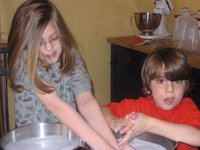A typical day...

New homeschoolers sometimes ask me to describe 'a typical day' of homeschooling. The most honest answer, that there is no such thing as a typical day for us, is unhelpful and perhaps a little bit rude, so I usually offer a vague response like "well, sometimes we do some formal schoolwork but most days we just read and play or do projects and sometimes we take classes or go on trips." Recently, I met Lynn, mother of a 6 yr. old and an 8 yr. old, both of whom are unhappy at their school. She was interested enough in homeschooling to press for a more complete answer, so we sat down together and talked about all the things the kids and I do over the course of a days, weeks, and months that constitute our homeschooling program, such as it is.
We almost always begin our morning with math. Math is the only subject we pursue so diligently -- about an hour most days -- and we use several different approaches. We use lots of manipulatives, and Wren is working through the Singapore Math program, as well as some supplementary books on algebra, calculus, and primary-grade 'Challenge Math'. I do a lot of Montessori with Robin, as I did with Wren at the same age, as well as the Singapore Kindergarten program. Many days, our formal schooling ends with our math hour. The kids play freely or read books the rest of the day. Yesterday, they built an elaborate circus out of legos and other toys.
A few days a week we also 'do language'. I try to have Wren do 15 minutes of handwriting practice several times a week, but this falls to the wayside more often than I'd like. She usually memorizes a poem once every week or so, and I try to select poems that relate to what she's studying in history or science, or to any project we're in the midst of creating. Every other week we do a lesson from Writing Strands, and I encourage her to write in her journal each day. We study a new Greek or Latin root about every other week, and Wren is working through a primary-grade Latin workbook and dvd. I'm slowly teaching Robin his letter sounds, and several days a week we work on a page of his alphabet book. I read aloud to them each day, a chapter book in the afternoon (our current selection is The Wind In The Willows) and picture books at bedtime.
Roughly 3 times a week, but often not for several weeks at a time, Wren also works on history, science, and/or. We tend to do history and Latin more frequently than science and geography, but never more than two of these subjects in one day. Last year, Wren studied the ancients, and this year she is studying the medieval to early Renaissance. We read nonfiction to establish a few 'pegs' of important people and events and then delve into lots of historical fiction. We do a project or two each month -- this month Wren is designing her own coat of arms according to medieval heraldry. For geography, we are studying land and water forms, and making crayon-relief illustrations of some of the basics, as well as labelling blank maps with actual examples (of lakes, archipelagos, bays, etc). Science is catch as catch can -- lots of kitchen table experiments and plenty of non-fiction reading. Both kids are in the midst of Junior Rangers/Park Pals, and Justin, our resident physicist, engages the children in socratic conversations about how things work at the dinner table and in the car.
We never do more than 3 hrs of formal work each day, and we frequently go several days or even weeks without doing anything at all except for math. When I listen to my kids' playing, I'm confident they are learning, exploring, and growing, without any input from me. Wren reads a great deal, and learns much through books, and we also spend lots of time at the library and the Maryland Science Center. Both children are avid weavers, sculptors, painters, and all-around crafters, and both enjoy cooking. A typical day for us could include between 0 and 3 hours of schooling, and many hours of playing, reading, and making stuff. Another typical day might include a trip to the Maryland Science Center, the Walters, Cylburn Arboretum, or some other interesting destination. Or, we might just spend our day reading, painting, baking and playing. For us, the best thing about homeschooling is that we have the freedom to follow our leadings rather than a mandated curriculum.




